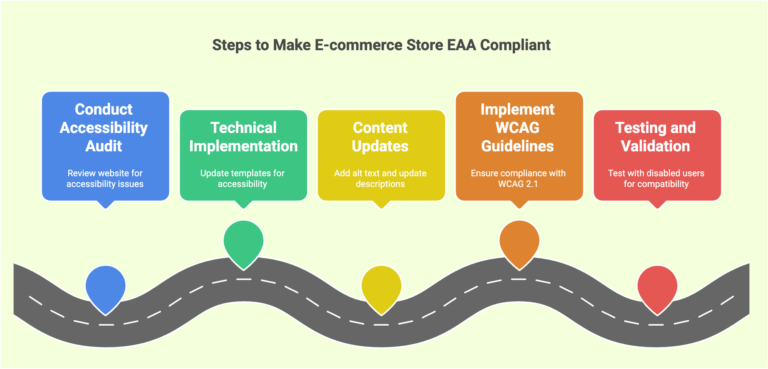Greetings! I'm Aneesh Sreedharan, CEO of 2Hats Logic Solutions. At 2Hats Logic Solutions, we are dedicated to providing technical expertise and resolving your concerns in the world of technology. Our blog page serves as a resource where we share insights and experiences, offering valuable perspectives on your queries.

| Quick Summary Starting in June 2025, the European Accessibility Act requires e-commerce sites to be accessible to people with disabilities. Your online store must comply with the EAA Act. Non-compliance risks fines and EU market access. |
Many e-commerce businesses aren’t accessible to people with disabilities. With the European Accessibility Act (EAA) coming into force. Making your store accessible isn’t just good practice, it is becoming a legal necessity for business success.
Get to Know the European Accessibility Act for E-commerce
The EAA, coming into effect in June 2025, directly impacts e-commerce businesses operating in the European market. If your online store has 10 or more employees and generates over €2 million in annual turnover, you must comply with these new accessibility requirements. This applies whether your business is based in the EU or simply sells to EU customers.
E-Commerce-Specific EAA Implications

The EAA has specific implications for online stores:
1. Website Accessibility
To make a website accessible, product listings must be screen-reader friendly. Proper keyboard navigation can be done for the shopping cart and checkout processes.
Descriptive alternative text should be added for product images. When displaying price information, it must be visible and accessible. Everyone should be able to filter and search functions easily.
2. Mobile Commerce
In mobile commerce apps must comply with and meet accessibility standards. Alternative interaction methods like voice commands or gesture recognition can be set up for touch interfaces.
Accessible alternatives can be added to product scanning features. When it comes to mobile, the payment systems should be universally accessible.
3. Customer Service
Users should be able to access support channels easily. Implement chat functions with screen reader compatibility. Keep the contact form able to navigate with the keyboard. Documentation should be available in multiple formats for everyone.
Technical Requirements for E-commerce Sites
To ensure compliance, your e-commerce platform needs:

1. Essential Features
Use ARIA landmarks like digital signposts or labels that help people using screen readers navigate your website. A clear heading structure should be given for the product categories.
2. Product Pages
The product page can be created with detailed product descriptions for screen readers. Proper colour and size selectors that work without mouse input can be used. The product price, product review, size charts, and product specifications and ratings can be made accessible.
3. Checkout Process
To make the checkout process easier for everyone, it can be made step-by-step with easy flow. Clear error identification in forms and multiple payment method options can be included.
Confirmation pages should be easily accessible. Checkout steps should be made easy to navigate between them.
The Risks of Non-Compliance with the EAA Act
If your website doesn’t comply with the EAA Act, it could have negative consequences. Let’s take a look at the disadvantages of non-compliance.
1. Financial Consequences
Violating these rules can result in fines of up to €100,000. Websites that are not accessible will face lost sales. Urgent platform modifications can be done to BFSG compliance with your website. This will help to avoid potential legal expenses.
2. Market Access
Whether you operate within the EU or from another country selling to the EU, you must follow the BSFG guidelines. Improper implementation could result in being blocked from the EU e-commerce market.
This restriction may limit your access to 135 million EU customers and put you at a competitive disadvantage compared to compliant stores. Implementing BSFG on your website helps prevent exclusion from marketplace platforms.
Must Follow Steps to Make Your E-commerce Store EAA Compliant

1. Conduct a website accessibility audit.
Conduct a thorough review of your e-commerce website. Test all shopping functions for accessibility. Analyzing how the mobile shopping experience goes is also necessary.
Evaluate the check-out process to identify issues that hinder the smooth checkout flow.
If required, get the help of experts to conduct an accessibility audit now to understand all the problems that limit BSFG compliance.
2. Technical Implementation
Product page templates should be updated with guidelines for e-commerce accessibility. Checkout flows should be made easy for everyone. Enhancing search and filter functions for accessible navigation patterns.
3. Content Updates
Add alt text to product images and create accessible product descriptions. Help documentation should be updated regularly for help and to ensure clear pricing information.
4. Implement WCAG 2.1 Guidelines
Ensure your website adheres to the Web Content Accessibility Guidelines (WCAG) 2.1 Level AA. These guidelines cover a wide range of accessibility issues, from visual impairments to motor
5. Testing and Validation
User testing can be conducted with disabled users to verify related issues. Screen reader compatibility, keyboard navigation, and mobile accessibility should also be tested.
Advantages of Accessible E-Commerce for Your Business
Making your store accessible offers significant benefits:
1. Market Expansion
This helps to reach more people who were previously unable to make purchases. About a million people have disabilities, and this will help to reach more of them.
2. Better Conversion Rates
An accessible store removes barriers, enabling a smoother shopping experience for all users. This leads to higher sales and improved customer retention.
3. Competitive Advantages
By prioritizing accessibility, you reduce cart abandonment, enhance customer satisfaction, and improve search engine visibility. This helps to set your business apart from competitors.
Next Steps for Your E-commerce Business
Start by assessing your platform for accessibility gaps, creating a clear compliance roadmap, and allocating the necessary budget for updates.
Introduce features like alt text, accessible navigation, and an optimized checkout to ensure inclusivity across all user interactions. Maintain compliance by conducting regular audits, training your team, and staying updated on accessibility standards to secure your store.
Conclusion
For e-commerce businesses, the EAA isn’t just about compliance. It’s an opportunity to expand your market and improve the shopping experience for all customers. It is time to verify your online store meets these essential accessibility requirements.
Start your EAA compliance journey today with 2Hats Logic Solutions. Our experts ensure your online store is ready for a more inclusive digital commerce future.
FAQ
What is the European Accessibility Act (EAA)?
The EAA is an EU directive introduced in 2019 to ensure products and services, including eCommerce websites, are accessible to people with disabilities. Compliance is required by June 2025
Who needs to comply with the EAA?
Any business trading within the EU, except microenterprises, must comply. Even non-EU sites serving EU customers must follow the EAA.
What are the main requirements for eCommerce sites under the EAA?
Key requirements include accessible checkout procedures, descriptive alt text for images, clear color contrasts, keyboard navigation, and accessible forms.
What happens if an eCommerce site doesn't comply with the EAA?
Non-compliance can lead to legal penalties, damage to brand reputation, loss of potential customers, and missed SEO opportunities.
How can eCommerce sites ensure they are EAA compliant?
Sites should run an accessibility audit, implement necessary fixes based on WCAG 2.1 guidelines, regularly monitor their site, and train their teams on accessibility practices.
Table of contents
- Get to Know the European Accessibility Act for E-commerce
- E-Commerce-Specific EAA Implications
- Technical Requirements for E-commerce Sites
- The Risks of Non-Compliance with the EAA Act
- Must Follow Steps to Make Your E-commerce Store EAA Compliant
- Advantages of Accessible E-Commerce for Your Business
- Next Steps for Your E-commerce Business

Related Articles






